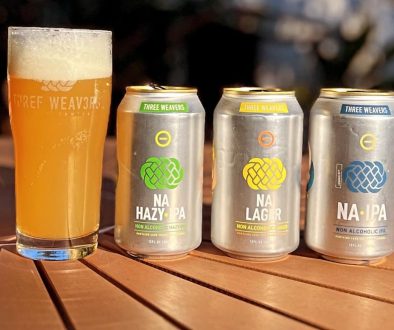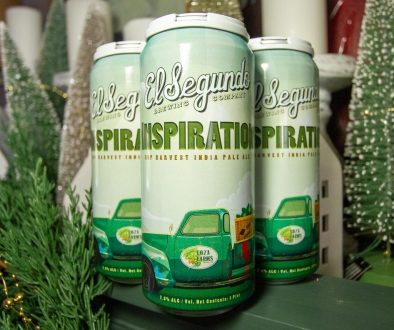Hopping Mad – In Defense of the Session IPA
The craft beer culture in America was built on individuality the promise of choice — on offering an alternative to the homogenized lagers that dominated the market for so long — but among today’s enlightened craft beer connoisseurs is seems that the macro lagers even get more respect than the trendy session IPA.

As both an inveterate lover of hoppy brews and a vocal proponent of low-ABV but high-flavor brews, I find the hate leveled at session IPAs misplaced and counterproductive. Here in Southern California light bodied brews are prized in the summer months, and a pint that finishes dry with a snappy bitterness is doubly enjoyable as a refreshment when the heat is on. Add in a complex aroma that suggests tropical fruits, citrus or melon and — if you’ll excuse the colloquialism — a crushable sub-5% ABV, you have the blueprint for an unbeatable brew. So why do SIPAs catch so much flak from so many craft beer devotees?
Visit the comments section of nearly any post about session IPAs; spend time in Reddit’s r/Beer board, the BeerAdvocate forums, or anywhere else that beer is discussed online, and you’re sure to hear plenty of vitriol aimed at the flourishing sub-style. Last week, prolific beer writer Aaron Goldfarb penned a would-be epitaph for the style — Does the Session IPA Still Matter? — for First We Feast that outlines the style’s supposed shortcoming and posits that no, the SIPA doesn’t matter because craft pilsners are becoming popular.
This proclamation had me scratching my head more than the more common, and more ill-thought out, internet criticism of my beloved session IPAs, and as much as I respect Goldfarb I think he was way off the mark with his ascertation that SIPAs have outlived their relevance.
Let’s look at the range of common arguments against the SIPA — some founded in reality while others seemingly based on nothing but prejudice. Most common perhaps is the reaction that the “session IPA” designation is a mere marketing trick — that the style is nothing new that that there is no need to label a beer a “session IPA” when the American pale ale style is well established and covers the same territory as the session IPAs. While that’s true based on the numbers — the ABV, IBU and SRM range of the SIPAs mostly fall inside the defined ranges for an American pale ale — this argument ignores the most important aspects of beer: the flavor. A well crafted session IPA will be lighter in body, drier in finish, and offer an expressive aroma of newer hop varieties, while a textbook APA should have more residual sweetness and will usually showcase the classic American “c hops”. Is there overlap between the two styles? Of course, but close similarity in beer styles is nothing new in the brewing world (just look at the differences, or lack thereof, between stout and porter). Yes, slapping the IPA label on a beer helps sell that beer, but that’s not the brewers fault or the beer’s fault — it’s a symptom of a young beer culture.
Common argument number two: the typical session IPA is too thin, too watery, and lacks the “malt backbone” to support hop character. This argument frustrates me because it belittles personal preference (perhaps the most important aspect of craft culture). Craft culture has finally developed a begrudging respect for the macro lagers, and the sentiment that there’s a time and a place for American Light Lager and other “lawnmower beers” is now well established. The same people that scoff at thin and watery SIPAs are the ones defending — as Goldfarb says — “macro swill”. A beer with a low ABV and a low final gravity is, by definition, “watery” but somehow this is okay for light lagers, but not light IPAs? I like hoppy beers, but sometimes I don’t want a lot of malt character or alcohol supporting the hop presence. Judging by the popularity of the session IPA style (they are the fastest growing segment of the IPA family according to the Brewers Association) there are plenty of people who feel similarly. Is the vocal minority of beer geeks that heap scorn on the session IPA simply committing the snobbish sin of arguing against what is popular for the sake of sounding well informed?
There’s a related criticism of SIPAs that hold more merit than most, but is still a poor argument against the popularity of the style: that session IPAs are inherently fragile. It’s true that SIPAs have less flavor stability than many styles, but again this is more of an issue with our current beer culture than an inherent flaw in the SIPA DNA. Be conscientious when buying session IPAs, keep them cold and drink them promptly and you shouldn’t have a problem.
Some people argue that the pricing of session IPAs is another problem — that since they fall below 5% ABV they should somehow cost the drinker less. This is a misunderstanding of the economics of beer. Sure, SIPAs don’t require as much malt to brew as other styles, but they use as much — and often more — hops, and the labor and process costs do not appreciably change for breweries.
The final argument, Aaron Goldfarb’s main reasoning behind the obsolescence of the session IPA, is that there are better session-friendly styles available for craft beer drinkers:
“Perhaps most excitingly, the session IPA may be a necessary bridge to milder styles that have long been marginalized in micro-brewing. Even as session IPA sales are up 199% since last year, craft breweries and their fans are starting to realize there are better options for their low-ABV needs. Look at the recent rise of the gose and Berliner weisse—more alcoholically restrained styles as well, but ones with more of a history and pedigree than the made-up session IPA.”
Suddenly “history and pedigree” are more important that flavor profile? Goldfarb’s acertation that session IPA is “made-up” and therefore inferior is stunningly short-sighted and ill-conceived. What does “better options for low-ABV needs” even mean? Better how? Without innovation, craft beer would never have spread further than Chico, California. The American Pale Ale is a “made-up” style — and like SIPA, APA began as just a small twist on a well-established historical style: the pale ales of England. Goldfarb goes on to suggest that the rise of the craft pilsner is the last nail in the coffin for the session IPA, but this too is a misguided argument. Pilsners — while wonderful — are lighter in color, heavier in body, less dry, usually less bitter and more restrained with their dry hopping than session IPAs. Pilsners also nearly always feature European or noble hops and are notoriously difficult to brew well. How does the rising popularity of craft-brewed pilsners impact the popularity of the session IPA at all? More importantly, why should the excellence of one style outweigh the draws of all other styles?
Perhaps my view is skewed as living in Southern California means I have easy access to some of the best examples of the session IPA genre. While the rest of the country looks to Daytime IPA from Lagunitas, All Day IPA from Founders, or [tk] as the paragon of the style, SoCal SIPAs are in another class altogether. Stone’s new-and-improved Go To IPA, Firestone Walker’s refined Easy Jack, and the local favorites like Stateside from Three Weavers, Ponto from Pizza Port and the dual offerings from Societe Brewing are some of the best examples of the session IPA being made today.
We’re spoiled for choice in Southern California, and that’s just the way we like it.




August 31, 2016 @ 4:29 pm
When I head out for the day, it is not a stretch to say I will see more British auto repair shops than actual British automobiles on the street. They’re costly high maintenance vehicles, but people like their Range Rovers all the same. More power to them.
Likewise, it is your prerogative to enjoy these fragile, relatively expensive beers. Some people just happen to believe there are superior alternatives. For my part, I like the newer, slightly lower gravity IPAs like Luponic Distortion and Oskar Blues IPA, which feel far less compromised.
Craft Beer News and Notes - 8/30 | Beer Guys Radio
August 30, 2016 @ 9:46 am
[…] Defending the Session IPA (Source: The Full Pint) […]